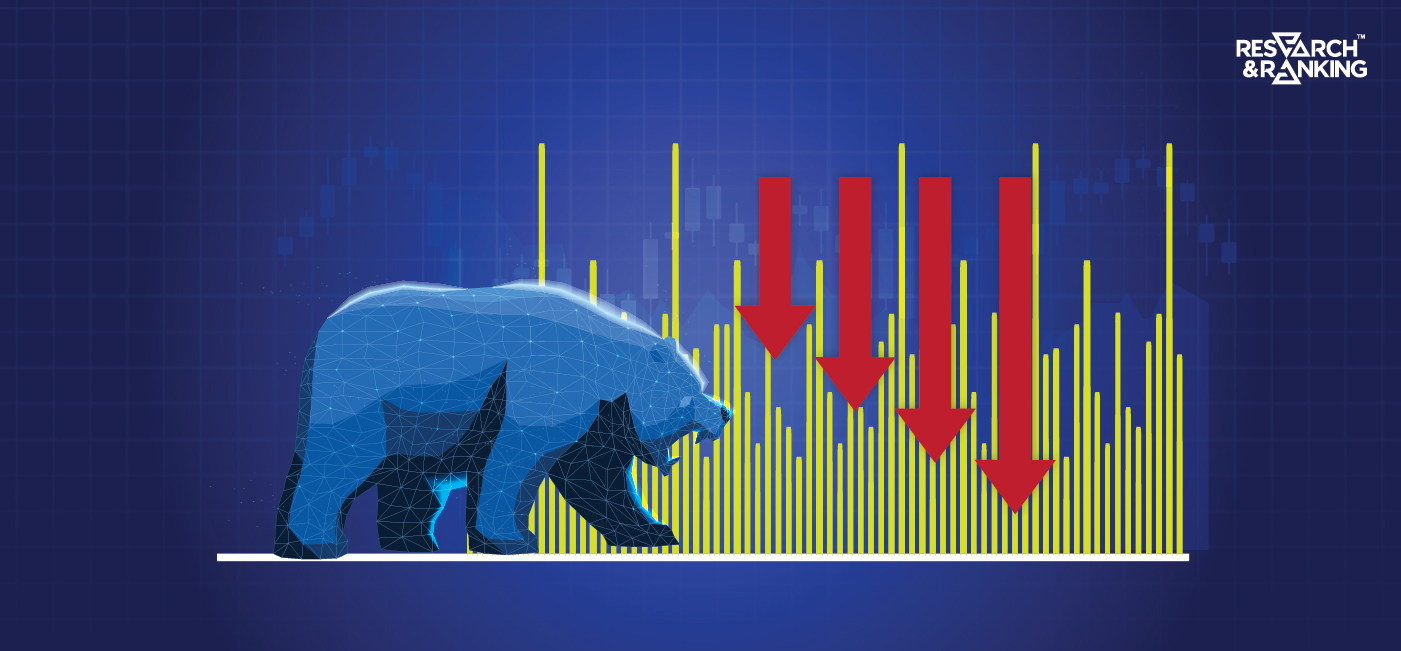The Indian stock market rose green today after a steep downfall on Monday, October 25, 2023. Nifty 50 opened at 19,320 while Sensex at 64,700. The crash was estimated to be the worst in the last seven months. The Nifty 50 chart looked like a long bearish candlestick, indicating a sharp market downturn.
What led to a steep fall? Let’s find out.
Here’s what the Indian stock market looked like on Monday, October 23, 2023.
| Index | Closing Price | Change (Points) | % Change |
|---|---|---|---|
| NSE Nifty | 19,281.75 | -260.9 | -1.34 |
| BSE Sensex | 64,571.00 | -825.74 | -1.26 |
The stock market indices NSE Nifty plunged by 260.90 points or 1.34% to finish trading at 19,281.75.
The BSE Sensex also dropped by 825.74 points or 1.26% to close at 64,571 – the most significant single-day loss since July 1. Collectively, the Indian stock market crashed as both the 30-share BSE Sensex and 50-share NSE Nifty plunged by over 1.25%.
The top losing companies included JSW Steel, Tata Motors, Tata Steel, Tata Consultancy Services, NTPC, Wipro, HCL Technologies, State Bank of India, Larsen & Toubro, UltraTech Cement, IndusInd Bank, Kotak Mahindra Bank, Power Grid and Reliance Industries Limited. On the flipside, Mahindra & Mahindra and Bajaj Finance did well.
What’s more? The Economics Times revealed that the Indian Stock market crash on Monday resulted in massive losses reaching up to ₹7.56 lakh crore to investors.
So, what was the reason? Was it the beginning of another pandemic? No. Let’s find out.
4 Primary Reasons Behind the Indian Stock Market Crash
1. Glaring Tensions in the Middle East
The Sensex and Nifty saw a significant drop, primarily due to escalating Middle East geopolitical tensions resulting from the Israel-Hamas conflict. Over 6,000 casualties occurred, and fears persist of the conflict spreading across the region.
According to Shrikant Chouhan, head of equity research at Kotak Securities, this tension triggered a wave of market selling pressure, increasing uncertainty and dampening global sentiment. Varun Aggarwal, founder of Profit Idea, also noted adverse effects on US and European markets, with both falling around 1.5%, signifying a broader global sentiment shift, as reported by ANI.
2. Increase in US Treasury Yields
On Monday, the 10-year US Treasury yield climbed above 5% for the first time in 16 years. This surge is driven by expectations of higher interest rates. [Source: Bloomberg]
In simpler terms, the US Treasury yield measures the cost for the American government to borrow money and serves as a benchmark for various types of lending.
As per Bloomberg, this uptick in yields could have a ripple effect on broader markets, affecting borrowing costs for individuals, businesses, and governments in the US and internationally.
3. Rising US Dollar vs. Other Currencies
Avinash Gorakshkar from Profitmart Securities pointed out that the US Dollar Index, which gauges the value of the US Dollar against other foreign currencies, has consistently remained above 106 for the past week. This has occurred despite the US Federal Reserve’s cautious approach to interest rate increases.
According to Gorakshkar, this could contribute to the recent sell-off pressure experienced by the Indian equity markets.
4. Inflation Hiccups
Avinash Gorakshkar added that crude oil prices have been continuously rising due to the outbreak of the Israel-Hamas conflict. The government imports over 85% of its oil demand, which is expected to strain the national finances. As a result, the market is particularly concerned about the potential increase in inflation following the prolonged Israel-Palestine conflict.
Nevertheless, the Indian benchmark equity indices, Sensex and Nifty 50, opened positively today, buoyed by positive global market indicators.
Frequently Asked Questions
Will you lose all your money in a stock market crash?
No, a stock market crash simply means a price decline, resulting in losses for many investors, but it doesn’t entail a complete loss of all funds. Actual losses occur only when positions are sold during or after the crash.
What were the major reasons for the recent Indian stock market crash?
Glaring tensions in the Middle East, increase in U.S treasury yields, Inflation hiccups, rising dollar currency vs other foreign currencies attributed to the recent Indian stock market crash.
How useful was this post?
Click on a star to rate it!
Average rating 4.2 / 5. Vote count: 14
No votes so far! Be the first to rate this post.
I’m Archana R. Chettiar, an experienced content creator with
an affinity for writing on personal finance and other financial content. I
love to write on equity investing, retirement, managing money, and more.
-
Archana Chettiarhttps://www.equentis.com/blog/author/archana/
-
Archana Chettiarhttps://www.equentis.com/blog/author/archana/
-
Archana Chettiarhttps://www.equentis.com/blog/author/archana/
-
Archana Chettiarhttps://www.equentis.com/blog/author/archana/

